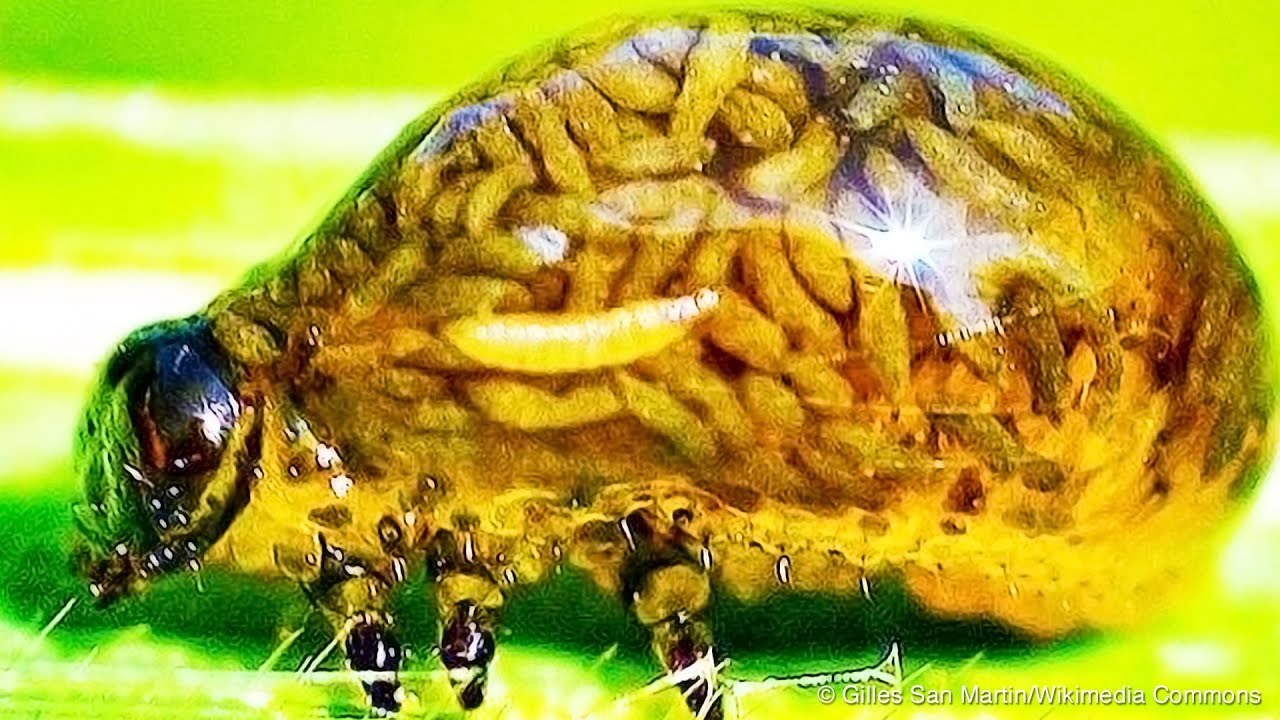10 Creatures That Prove Superpowers Actually Exist
Superpowers like living forever, surviving without oxygen and imitating any sound. Bright Side found some creatures with abilities that are even more surprising, funny, weird, and sometimes disgusting than any superhero. Make sure to watch this video till the end – you don’t want to miss the proof zombie apocalypse could be something very real, do you?
TIMESTAMPS
Immortal jellyfish
Naked mole-rat
Tardigrade
Hairy Frog
Mantis shrimp
Mimic Octopus
Platypus
Criocerinae leaf beetle
Flea
Lyrebird
SUMMARY
Top 3 Most Amazing Creatures:
– The immortal jellyfish begins its life as a tiny free-swimming blob called a planula, which grows into a colony of polyps and then develops into a jellyfish. If it’s attacked, is exposed to environmental stress, or simply becomes sick or old, it can revert to the polyp stage, forming a new polyp colony, which makes it immortal.
– Naked mole-rats can live ten times as long as a mouse. Recent studies prove they can survive without oxygen!
– Tardigrade. These little, near-microscopic animals are considered nature’s toughest creatures as it is almost impossible to kill them. With eight legs and hands with claws, they can live basically anywhere sucking algae juice, lichens and moss.
Animation is created by Bright Side.
Naked Mole Rats: By Edward Russell, CC BY 2.0 https://creativecommons.org/licenses/by/2.0, https://www.flickr.com/photos/21837558@N00/120333577
Naked Mole Rats: By Edward Russell, CC BY 2.0 https://creativecommons.org/licenses/by/2.0, https://www.flickr.com/photos/edrussell/176440305
Naked mole rat community “Off Shift”: By Bob Owen, CC BY 2.0 https://creativecommons.org/licenses/by/2.0, https://www.flickr.com/photos/bobowen/4252523174
A nest of naked mole rats: By Benny Mazur, CC BY 2.0 https://creativecommons.org/licenses/by/2.0, https://www.flickr.com/photos/benimoto/2446311137/in/photolist-4JaZ5e-a6B481-a6ybYB-4fS8Go-aRzyNP-4yWNCV-gAiye-58jEbx-a6yb1K-iMWga-a6AYau-a6y9sk-a6AWvs-a6AYAW-a6y6E4-a6ybvM-a6AZvY-a6AXKU-a6y6ea-a6AZ5o-a6B1DN-a6yavV-cvNVyC-qGnPs-7SsuXQ-f6KPBu-f6KRMA-7SbjQv-cgLrGq-a5TDdV-cgLrKo-cgLrPN-a5Srg4-a5TSRM-c1YdxJ-aKjjPV-9FaGR9-9DqtGT-dvxkrJ
SEM image of Milnesium tardigradum in active state: By Schokraie E, Warnken U, Hotz-Wagenblatt A, Grohme MA, Hengherr S, et al. (2012) – Schokraie E, Warnken U, Hotz-Wagenblatt A, Grohme MA, Hengherr S, et al. (2012) Comparative proteome analysis of Milnesium tardigradum in early embryonic state versus adults in active and anhydrobiotic state. PLoS ONE 7(9): e45682. doi:10.1371/journal.pone.0045682, CC BY 2.5 https://creativecommons.org/licenses/by/2.5, https://commons.wikimedia.org/w/index.php?curid=22716809
An example of Trichobatrachus robustus, The hairy frog, at the Natural History Museum of London: By Gustavocarra – Own work, CC BY-SA 4.0 https://creativecommons.org/licenses/by-sa/4.0, https://commons.wikimedia.org/w/index.php?curid=3991077
Platypus in Broken River, Queensland: By Peter Scheunis – Own work, CC BY 1.0 https://creativecommons.org/licenses/by/1.0, https://commons.wikimedia.org/w/index.php?curid=103809
Leaf Beetle larva of the subfamily Criocerinae (Coleoptera, Chrysomelidae, Criocerinae, genus Lema sp. or Oulema sp.) The larva is covered by its own excreta Locality : Jambes, Belgium: By Gilles San Martin – Own work, CC BY-SA 3.0 https://creativecommons.org/licenses/by-sa/3.0, https://commons.wikimedia.org/w/index.php?curid=17595004
Superb Lyrebird (Menura novaehollandiae), Mt Buffalo, Victoria: By CSIRO, CC BY 3.0 https://creativecommons.org/licenses/by/3.0, https://commons.wikimedia.org/w/index.php?curid=35491201
The elusive Superb Lyrebird – 005 Male singing: By Rexness, CC BY 2.0 https://creativecommons.org/licenses/by/2.0, https://www.flickr.com/photos/rexness/25912016286/in/photostream
Wasp parasitized by the fungus Cordyceps (order Hypocreales): By Erich G. Vallery, USDA Forest Service – SRS-4552, Bugwood.org, CC BY 3.0 https://creativecommons.org/licenses/by/3.0, https://commons.wikimedia.org/w/index.php?curid=4476437
Puppenkernkeule, Cordyceps militaris: By Deutsche Gesellschaft für Myklogie – http://dgfm-ev.de/index.php?id=pdj_2007, CC BY 3.0 https://creativecommons.org/licenses/by/3.0, https://commons.wikimedia.org/w/index.php?curid=6017129
Subscribe to Bright Side : https://goo.gl/rQTJZz
—————————————————————————————-
Our Social Media:
Facebook: https://www.facebook.com/brightside/
Instagram: https://www.instagram.com/brightgram/
SMART Youtube: https://goo.gl/JTfP6L
5-Minute Crafts Youtube: https://www.goo.gl/8JVmuC
Have you ever seen a talking slime? Here he is – Slick Slime Sam: https://goo.gl/zarVZo
—————————————————————————————-
For more videos and articles visit:
http://www.brightside.me/



![[ID: jvNU5bwzclI] Youtube Automatic](https://bizimtube.com/wp-content/uploads/2021/03/id-jvnu5bwzcli-youtube-automatic-236x133.jpg)
![[ID: 0yCJMt9Mx9c] Youtube Automatic](https://bizimtube.com/wp-content/uploads/2021/03/id-0ycjmt9mx9c-youtube-automatic-236x133.jpg)
![[ID: vAJM5EdDwjU] Youtube Automatic](https://bizimtube.com/wp-content/uploads/2021/03/id-vajm5eddwju-youtube-automatic-236x133.jpg)
![[ID: LxOmofEFub4] Youtube Automatic](https://bizimtube.com/wp-content/uploads/2021/03/id-lxomofefub4-youtube-automatic-236x133.jpg)
![[ID: wFAh77GBsHs] Youtube Automatic](https://bizimtube.com/wp-content/uploads/2021/03/id-wfah77gbshs-youtube-automatic-236x133.jpg)
![[ID: tjwrG4Debc4] Youtube Automatic](https://bizimtube.com/wp-content/uploads/2021/03/id-tjwrg4debc4-youtube-automatic-236x133.jpg)
![[ID: _28bYGZtnU8] Youtube Automatic](https://bizimtube.com/wp-content/uploads/2021/03/id-28bygztnu8-youtube-automatic-236x133.jpg)
![[ID: 1e7bhUjUEJ8] Youtube Automatic](https://bizimtube.com/wp-content/uploads/2021/03/id-1e7bhujuej8-youtube-automatic-236x133.jpg)
![[ID: QjyCviSKY2U] Youtube Automatic](https://bizimtube.com/wp-content/uploads/2021/03/id-qjycvisky2u-youtube-automatic-236x133.jpg)
![[ID: -5i-vB4-kFk] Youtube Automatic](https://bizimtube.com/wp-content/uploads/2021/03/id-5i-vb4-kfk-youtube-automatic-236x133.jpg)
![[ID: covHhQgr5kU] Youtube Automatic](https://bizimtube.com/wp-content/uploads/2021/03/id-covhhqgr5ku-youtube-automatic-236x133.jpg)
![[ID: mX7FEHws43A] Youtube Automatic](https://bizimtube.com/wp-content/uploads/2021/03/id-mx7fehws43a-youtube-automatic-236x133.jpg)